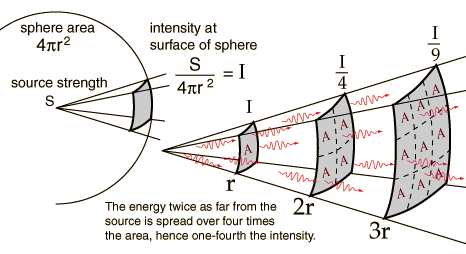Quote:
Originally Posted by enialal

1) What if I sit closer than the recommended viewing distance, what benefits would be lost/would I not get?
2) What if I sit beyond the recommended viewing distance, what benefits would be lost/would I not get?
|

The Viewing Distance Post
.
Increases in Resolution gives us more viewing options; not all of them will allow your eyes completely resolve what your display is capable of.
Viewing Distances based on Visual Acuity
The distance we need to be from the set is based on
spatial resolution (how closely lines can be resolved), screen size and
visual acuity. Nominal (Snellen, 1862) acuity is 20/20 (feet) or 6/6 (meters) where the optotype glyphs (sloan letters, tumble E, numbers or geometric symbols) would
subtend at 5' of arc on the
retina, and the strokes, 1' of arc. 20/40 (0.5) is 85% the effiency (not 50%) of 20/20 (1.0) which means someone with this vision is taking in less information, as defined by the
Inverse Square Law for point sources. At any rate, 20/20 determines the angular size, 1 arcminute or 1/60 of a degree - the smallest detail one can see having this level of acuity. This works out to be 0.0698inch/1.77mm at 20 feet and can be used to determine the pixel size we can see at some distance n. Contrast also plays a role: the lower the contrast, the less detail we can perceive.

Details size of up to 1.5 arcminutes are cosidered sharp to the viewer and so this is what determines the distance from and/or the size of the set. For 1080p, this will be 1.1 times image width or 32.86 deg; for 720p, it is 1.75 times image width; and for 480p, 3 times image width. So if the resolution of program material changes, you are going to have to keep moving you chair if you want to sit at the optimum distance when viewing 480/720/1080p sources. Also, since our eyes have different visual acuity, the
Viewing Distance Chart are only a guide, not an absolute. You are going to have to pick what is good for you and your eyes.
 Viewing Distance and the Pythagorean theorem: aē + bē = cē
Viewing Distance and the Pythagorean theorem: aē + bē = cē
A few steps are necessary as we are only given a value for the diagonal or hypotenuse and a ratio of 16:9 that is shared by all widescreen TV regardless of size. We also don't know any angles in the right triangle other then 45 deg. Let a = adj, b = opp.
We start by letting a = 16 and b = 9 and creating the ratio b/a = 9/16;
We then use arctan x = θ; arctan(9/16) = 34.22 degrees
40 inch TV: width 35", height 20".
42 inch TV: width 37.5", height 21":
width: 42cos(34.22) = 34.729; height 42sin(34.22) = 23.61
Visual Acuity:
TV Size and Resolution Info

Quote:
Originally Posted by dobyblue

You can have a 100" TV and not tell the difference, it all depends on your viewing distance...
A 22" LCD would allow you to appreciate 1080p if you were sitting 2-3 feet in front of it, like most people do with a computer monitor.
|
Other Posts
 Glossery
Inverse Square Law
Glossery
Inverse Square Law
Where some physical quantity is inversely proportional to the square of the distance from the source.
 1 arcminute of resolution
1 arcminute of resolution, The typical resolving power of the human eye,
Screen Format, Aspect ratio
Throw Ratio, A ratio between projection distance and width of image. distance(D)/screen width(W).
SMPTE 30, 1.6263 times the screen size in a 16:9 TV.
THX 40, Divide the diagonal screen measurement by .84
THX Range, Minimum 40 deg, Mximum 28 deg.
NTSC, 10 deg.
Variables:
Screen Width
Distance
Viewing Angle
Viewing Location
Trig Functions
sin θ = opp/hyp = b/c; csc θ = 1/sin θ = 1/(b/c) = c/b
cos θ = adj/hyp = a/c; sec θ = 1/cos θ = 1/(a/c) = c/a
tan θ = opp/adj (tan θ = sin θ/cos θ); cot θ = cos θ/sin θ
Pythagorean trigonometric identity, sinē θ + cosē θ = 1
(sin θ)ē = sinē θ; (cos)ē = cosē θ;
sin θ = b/c; sinē θ = bē/cē
cos θ = a/c; cosē θ = aē/cē
bē/cē + aē/cē = (bē + aē)/cē
sinē θ + cosē θ = 1ē or sinē θ + cosē θ = 1 for angles between 0 and π/2.
The Derivatives
sin' x = cos x, csc' x = -csc x cot x
cos' x = -sin x, sec' x tan x
tan' x = secēx, cot'x = -cscēx
Trigonometric Intergrals
∫ cos x dx = sinx + C
∫ sin x dx = - cosx + C
∫ tan x dx = ln |sec x| + C
Quote:
Originally Posted by Penton-Man

How good are your eyes? (if you can appreciate the aliasing artifacts in the welder's shirt here....
http://www.avsforum.com/avs-vb/showp...&postcount=162
then the difference between 2k and 4k should be easily obvious to you if you are willing to sit close enough to your display at home.
Expect professional desktop-sized 4k monitors which are practical for on-set usage, as knowledgeable D.P.’s are already clamoring for them… https://forum.blu-ray.com/blu-ray-te...ml#post5405008
-especially to examine for noise when the D.P. could be getting close to pushing the limits of the exposure during a particular scene while shooting with high resolution cameras like the Sony F65 or the Red Epic. |
Back to
Getting Started HD POST






























 Linear Mode
Linear Mode

